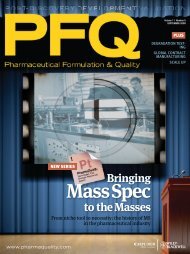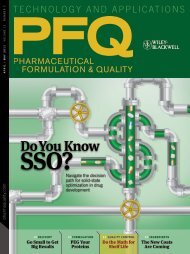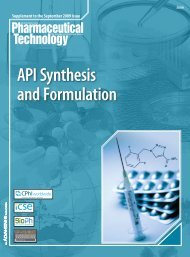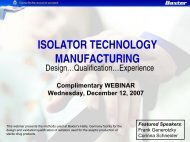Practical Technologies for Lyophilization - Sterile Parenteral Drug ...
Practical Technologies for Lyophilization - Sterile Parenteral Drug ...
Practical Technologies for Lyophilization - Sterile Parenteral Drug ...
You also want an ePaper? Increase the reach of your titles
YUMPU automatically turns print PDFs into web optimized ePapers that Google loves.
Biopharma Technology’s Lyotherm 2 provides an integrated differential thermal analyzer and an<br />
electrical impedance capability in one instrument. Lyotherm 2 has been designed to measure<br />
glass transition, eutectic melt, and melting temperatures relevant to freeze drying.<br />
bles. The FluroTec coating eliminates the<br />
need <strong>for</strong> silicone oil lubrication thus preventing<br />
particulate contamination.<br />
“A key point to note with respect to<br />
any stopper is that it should be<br />
already dry prior to placement on the<br />
product vial preceding lyophilization.<br />
<strong>Lyophilization</strong> cycles are designed<br />
with drug product characteristics and<br />
not stopper characteristics in mind,”<br />
comments DeGrazio.<br />
Material Science Approach<br />
Baxter Biopharma Solutions (www.<br />
baxterbiopharmasolutions.com) offers<br />
services that support freeze-drying <strong>for</strong>mulation<br />
and process development from<br />
the research and development stage all<br />
the way to commercial production runs<br />
<strong>for</strong> clinical and commercial products. Its<br />
freeze-drying facility in Bloomington,<br />
IN, can handle products of varying<br />
batch sizes and volumes using one or<br />
more of six commercial size and one<br />
clinical size freeze dryers.<br />
From a technology perspective, Baxter<br />
adopts a materials science approach in<br />
developing a freeze-drying process,<br />
according to Steven Nail, Ph.D., senior<br />
research scientist at Baxter. “We per<strong>for</strong>m<br />
a comprehensive thermal analysis, and<br />
freeze-dry microscopic analysis to optimize<br />
process parameters. For freezedried<br />
protein <strong>for</strong>mulations, we have the<br />
capability to interface FTIR with the<br />
freeze-dry microscope to examine secondary<br />
structure of proteins in real-time<br />
during freeze-drying. Currently, Baxter is<br />
the only company that applies<br />
FTIR/freeze-dry microscopy technology<br />
in freeze-drying process development.”<br />
Existing Challenges in<br />
<strong>Lyophilization</strong><br />
While freeze drying is the preferred<br />
method to remove water from a product,<br />
it has its limitations. Biomolecules can be<br />
adversely impacted due to the stresses of<br />
the freezing and/or drying process. “The<br />
challenge is how do we optimize the<br />
freeze-drying process to make a pharmaceutically<br />
acceptable product in a costeffective<br />
manner. Drying operations can<br />
be quite expensive. For example, the cost<br />
of a production freeze dryer can be<br />
greater than $3 million. Because of the<br />
high value of the product produced in a<br />
typical batch of freeze-dried injectable<br />
product, the need <strong>for</strong> redundancy in<br />
refrigeration equipment and vacuumpumping<br />
equipment adds considerably<br />
to the cost,” says Dr. Nail.<br />
Another challenge is achieving the<br />
target moisture content in a specific<br />
product. The last of the solute-bound<br />
residual water in the product is<br />
removed during secondary drying. The<br />
secondary drying process is critical as<br />
not all of the water is in frozen <strong>for</strong>m so<br />
product has to be dried carefully. Overdrying<br />
can result in a less stable product.<br />
“Baxter will soon be acquiring a<br />
process analytical technology capability,<br />
an in-process mass flow meter that<br />
allows precise monitoring of water<br />
removal. This meter will integrate mass<br />
flow rate throughout a freeze-dry cycle,<br />
giving the cumulative mass of water<br />
removed,” explains Dr. Nail.<br />
Design of the correct <strong>for</strong>mulation<br />
remains a challenge. “Customers typically<br />
determine their <strong>for</strong>mulations in<br />
an empirical manner and it can be<br />
exceedingly difficult to convince a<br />
customer to change to a better <strong>for</strong>mulation.<br />
Inappropriately designed <strong>for</strong>mulations<br />
and cycle continue to be a<br />
bane, an issue that FDA is well aware<br />
of,” states Dr. Nail.<br />
Product comparability between<br />
freeze drying and liquid <strong>for</strong>mulations<br />
is another issue. “Clients sometimes<br />
prefer liquid <strong>for</strong>mulations <strong>for</strong> the<br />
final marketed product, while freezedrying<br />
product has advantages during<br />
clinical development due to its stability,<br />
ease of storage, and flexibility <strong>for</strong><br />
dosing at multiple concentrations.<br />
The transition to a different final<br />
dosage <strong>for</strong>m late in development or<br />
post-development may require<br />
demonstration of product comparability,”<br />
says Dr. Kelly.<br />
November 15, 2006 genengnews.com Genetic Engineering & Biotechnology News






